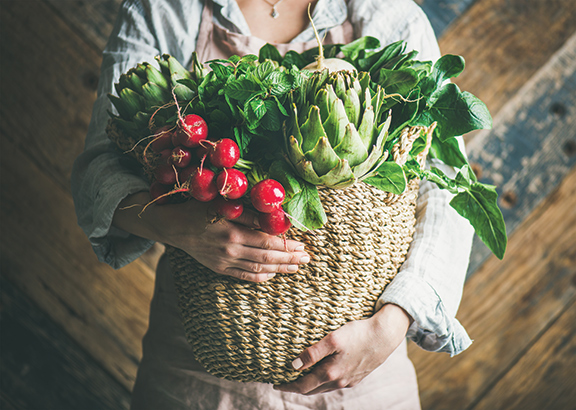BY KEBBIE STINE, MNT
Have you ever gone on a diet? Statistics show that an estimated 97 million people go on some sort of diet every year in the US, and we are spending a whopping $66 billion on weight loss products! Yet 62% of Americans are overweight or obese, with an ever increasing number of children falling into that category. These numbers are staggering, and completely unnecessary. Fad diets are temporary and rarely do they produce the desired outcome; permanent lifestyle changes are much more effective for keeping us healthy and decreasing waist size. Enter “clean eating.” What does it mean to eat clean you ask?
The term “clean eating” is a buzz worthy phrase that basically means to eat real food in its natural state. This sounds so simple, but thanks to modern agricultural practices and massive marketing campaigns the Standard American Diet (SAD) consists mostly of processed/refined foods that come prepackaged for our convenience. Foods that line the middle aisles and freezer section in the grocery store have been altered to make them shelf-stable, more appetizing and even addictive (the exception is frozen fruits and vegetables). The producers of these foods do this by stripping nutrients and adding harmful preservatives, additives, dyes and sugar…loads of sugar.
Let’s talk sugar for a moment. The American Heart Association recommends the average adult consume no more than 25 grams of added sugar per day, however the average daily intake is actually closer to 80 grams per day! To put that into perspective, 80 grams of sugar is equal to 19.6 teaspoons and 310 calories. Most of our sugar consumption is coming from packaged foods, fast foods and beverages like soda, juice and alcohol. Sugar can be tricky to avoid since there are over 50 different names for sugar allowed on food labels.
That brings us to food labels. Reading food labels and outsmarting “healthy” marketing schemes is an absolute game changer! If you are going to purchase packaged food (which, let’s be honest, we all do and will continue to do) set some boundaries. If there are ingredients that you cannot pronounce or don’t know what they are, skip it. When possible only purchase packaged foods with five ingredients or less. Don’t fall for labels that say – heart healthy!, enriched with vitamins!, natural! – or any other labeling tactics the food industry uses to lure you. These labels actually do more harm than good because they are tricking consumers into thinking they are making healthy choices when in fact these foods are making us fat and sick. So what are we to do?
I’m glad you asked, and this brings us full circle back to that term “clean eating.” I get asked all of the time which diet is the best, and my go-to answer is to eat real, high quality, minimally processed food…that’s it! When you eat food as close to its natural state as possible you are automatically avoiding added sugars, chemical additives, preservatives and dyes. Here are the basics of “eating clean”:
Unprocessed Foods
• Fruits
• Vegetables
• Dried legumes (beans)
• Eggs (preferably from pastured hens)
Minimally Processed Foods
• Unrefined grains like brown rice, oats and quinoa
• Organic dairy products (always choose organic to avoid hormones, antibiotics and other harmful chemicals)
• Grass-fed or pastured meats
• Wild caught fish (avoid farmed fish)
• Unrefined oils like extra virgin olive oil, avocado oil, coconut oil or grass fed butter
Organic vs Conventional Produce
• Always buy organic: fruits and veggies with edible skins (berries, apples, pears, potatoes)
• Okay to buy conventional: fruits and veggies with inedible skins (avocados, melons, squash, citrus)
Beverages
• Water is always the best choice (filtered water is even better)
• Tea and coffee (avoid sugar laden creamers)
• Occasionally 100% juice (no sugar added)
Shop the Perimeter!
• The fresh food is always on the perimeter of the store because it spoils faster (no preservatives=healthy!)
• Packaged shelf-stable foods are in the interior aisles (preservatives)
Eating clean requires some effort: planning, cooking and eating at home are imperative. Making your food is the only way to control your ingredients and guarantee success. That doesn’t mean you can never eat out again, but the majority of your meals should be prepared at home. The payoff is immense and includes perks like more energy, better sleep, glowing skin and a long, healthy life!
Kebbie Stine is a Master Nutrition Therapist in the Denver area. She practices nutrition therapy at Washington Park Chiropractic, Integrative Health, and is the owner of Whole Choice Nutrition Therapy. Contact Kebbie at kebbiestine@gmail.com

